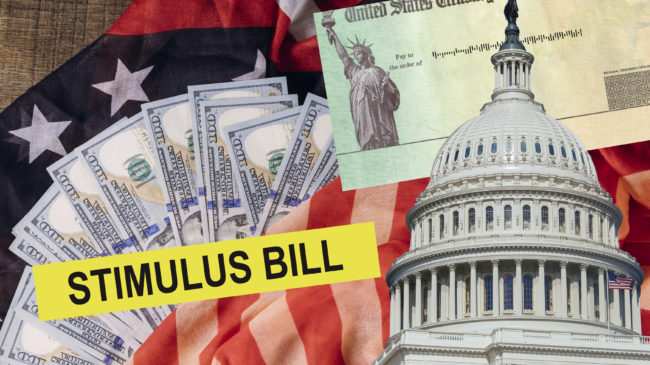Before the first payments from the $2.3 trillion Coronavirus Aid, Relief, and Economic Security Act (CARES Act), the largest spending bill in history, started reaching bank accounts this week, politicians were already calling for another round of faulty economic stimulus to combat COVID-19 and the devastating economic impacts of the government-imposed shutdowns.
Speaker of the House Nancy Pelosi is calling for another $1 trillion in stimulus, while President Trump wants an additional $2 trillion stimulus.
Meanwhile, it is early, but the rollout of the CARES Act looks like another blundered federal program that grows the national debt by trillions, lacks accountability, bails out favored industries and, despite the record price tag, still underfunds the areas that need it the most. Out of the massive $2.3 trillion, less than half is being spent in a productive fashion on small businesses and individuals.
While the scale of the COVID-19 pandemic is extreme, the equally large scale of the CARES Act cannot be understated in economic terms. However, the $2.3 trillion bill fails to get money to the right places.
Unfortunately, a vital part of the stimulus program — the direct cash payments to individuals — just started reaching people via direct deposit this week and those who are getting checks haven’t gotten them yet thanks to the federal bureaucracy’s ineffectiveness and President Trump’s request to have his name on the checks. Over 17 million people, an astonishing record, have applied for unemployment benefits in the last three weeks, and yet the federal government has lagged in getting the stimulus money to them.
The Paycheck Protection Program’s loans for small businesses that include incentives for them to keep their workers on the payroll arguably does the most to help businesses in need. But the funding provided for this program is too small a number relative to what it seeks to accomplish — keep millions of people employed by helping small businesses pay their bills while there’s little-to-no money coming in. The loans could also help avoid a crash in commercial mortgage-backed securities, which could be triggered by businesses based in malls and commercial office spaces shutting down. One analyst calculated the aggregate monthly expenses of small businesses at $258 billion, making the $377 billion small business portion of the bill large enough to cover roughly 45 days of operation.
Meanwhile, $560 billion is set aside for large corporations, including $58 billion for the airline industry. There’s no real economic justification for airlines to get targeted assistance ahead of any other struggling sector. And there’s another $17 billion for “national security” which will likely go to politically-connected firms (Lockheed Martin, Boeing, etc.) with no apparent connection to the COVID-19 pandemic.
The remaining $450 billion in big business funds is in the hands of the Federal Reserve and the Department of Treasury to make non-forgivable loans to mid- and large-sized businesses. Some expect the Treasury to leverage this money 10 to 1, meaning some $4.5 trillion in loans could be available — more than the entire outstanding commercial and industrial markets, which held $2.35 trillion at the end of 2019. The scale of this stimulus program is truly unprecedented and would make the US government the largest lender in the country.
With lawmakers already pushing another stimulus, taxpayers should be very concerned about the transparency and efficacy of these programs, which are almost certain to devolve into cronyism reminiscent of the 2008-2009 bailouts. President Trump has already fired the Inspector General who was supposed to oversee the stimulus spending. And less than a week after CARES was passed, Treasury Secretary Steve Mnuchin independently changed the terms Congress had set, making the loans less favorable for some businesses. The lack of details and oversight leave far too much wiggle room for bad policy and corruption.
As the economy worsens and calls for more stimulus grow, there comes a point when Americans need to worry about the massive expansion of the national debt, now $24 trillion and rising, and Federal Reserve power. “The federal government budget deficit is on track to reach a record $3.6 trillion in the fiscal year ending Sept. 30, and $2.4 trillion the year after that, according to Goldman Sachs estimates,” The Wall Street Journal reported this week. And that’s before the additional $2 trillion stimulus President Trump wants. At some point, the spending and red ink have to run out.
The Federal Reserve’s power has grown since the Great Recession, first moving past the traditional open market tactics (which it can no longer effectively use since it’s already pushed interest rates to near zero) into quantitative easing and last year’s historic $500 billion participation in the repo market. There has been a historically large, decade-long “pumping” of cheap money into the system even before the coronavirus pandemic.
Congress should not create another trillion-dollar stimulus. But if the political momentum for it is unstoppable, stimulus spending should focus on the small businesses and hourly-earners who are hardest hit by the economic impacts of government-imposed shutdowns. It doesn’t need to be complicated — direct cash payments, perhaps adjusted for income and employment, and widespread funding for small businesses in the vein of the Paycheck Protection Program.
A version of this column previously appeared in the Daily Caller.
